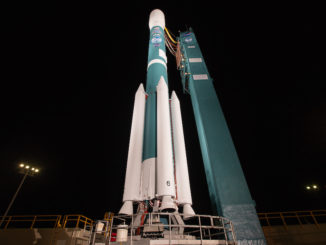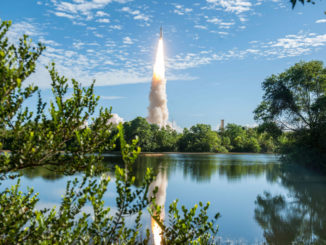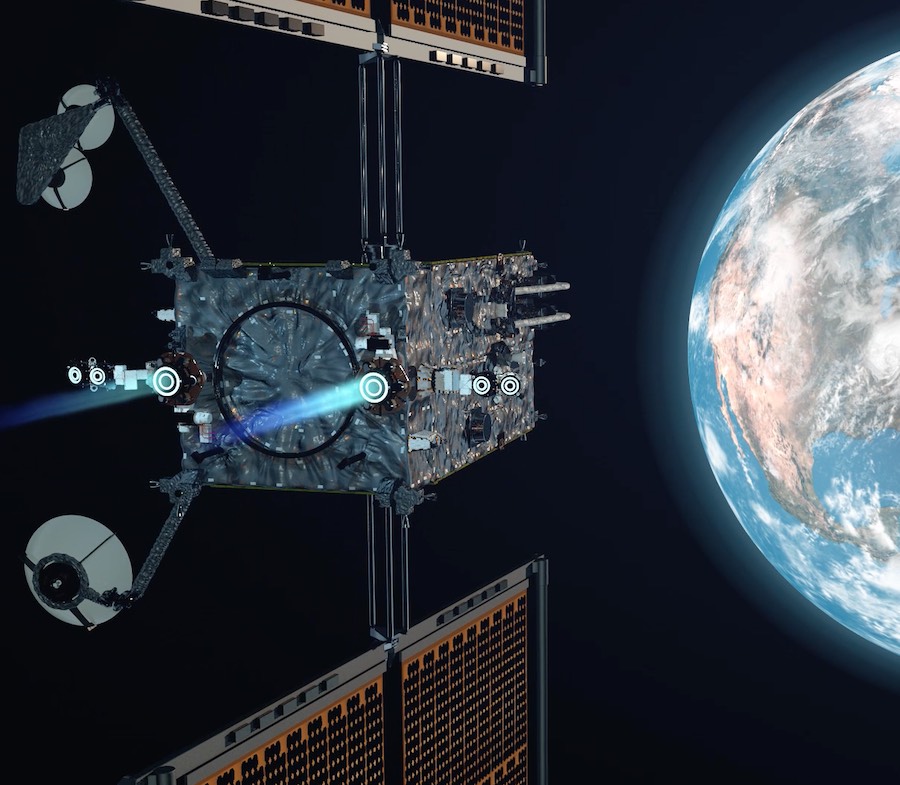
NASA has selected Maxar Technologies for a $375 million contract to design, build and launch the core element of a mini-space station in orbit around the moon that will double as a deep space research outpost and a staging point for future human expeditions to the lunar surface.
Fitted with high-power xenon thrusters and huge roll-out solar panels, the module will become the centerpiece of NASA’s planned Gateway station in lunar orbit. NASA plans to add a small pressurized habitat, or utilization module, to the Gateway before assembling components of a lunar lander there ahead of a human landing on the moon as soon as 2024.
The Gateway is a small space station that we will put in orbit around the moon,” said NASA Administrator Jim Bridenstine in a speech Thursday at the Florida Institute of Technology. “Think of it as a reusable command and service module that will be in orbit around the moon for 15 years, and the first element is the Power and Propulsion Element.”
The Gateway will serve as an operations base and safe haven for astronauts heading to the lunar surface, NASA says, and the Power and Propulsion Element, or PPE, will carry substantial maneuvering capabilities to change orbits, enabling crews departing the station to reach any part of the moon, such as a south pole location where measurements suggest water ice is present in permanently-shadowed craters.
Apollo astronauts landed in equatorial regions, but NASA wants future crews to explore the water ice deposits at polar landing sites, in hopes of eventually extracting the material to generate propellant, electricity, air and other consumables to support a long-term base.
Vice President Mike Pence charged NASA during a speech in March to return U.S. astronauts to the moon by 2024. The development of Gateway segments was already underway at the time of Pence’s speech, on a pace to prepare for a human lunar landing around 2028.
NASA officials say some pieces of the original Gateway concept, such as an airlock to support spacewalks, a refueling module provided by the European Space Agency, a Canadian-built robotic arm, and a possible Japanese contribution, will be deferred in favor of building a minimal station by 2024.
The Gateway’s first element will launch on a commercial rocket by the end of 2022, followed in 2023 by the launch of the station’s first pressurized segment, also on a commercial vehicle. The pressurized utilization module would have multiple docking ports to connect with the PPE, a lunar lander and visiting Orion crew capsules.
According to NASA’s current plan, commercial rockets would launch two or three pieces of a human-rated lunar lander that will be integrated at the Gateway in time for a 2024 landing attempt.
The astronauts that would land on the moon in 2024 would fly on the third tandem mission of NASA’s government-managed Space Launch System, an oft-delayed heavy-lift rocket now scheduled for its first launch no earlier than late 2020, and the Orion crew ferry craft.
NASA has named the accelerated lunar landing program Artemis, goddess of the moon and sister of Apollo in Greek mythology.
Under current plans, the Artemis 1 mission, formerly named Exploration Mission 1, will be the inaugural flight of the Space Launch System with the Orion crew capsule on an unpiloted flight to lunar orbit and back to Earth. After the Artemis 1 mission as soon as late 2020, the first SLS/Orion mission with astronauts would launch in late 2022 on a trip around the moon and back.
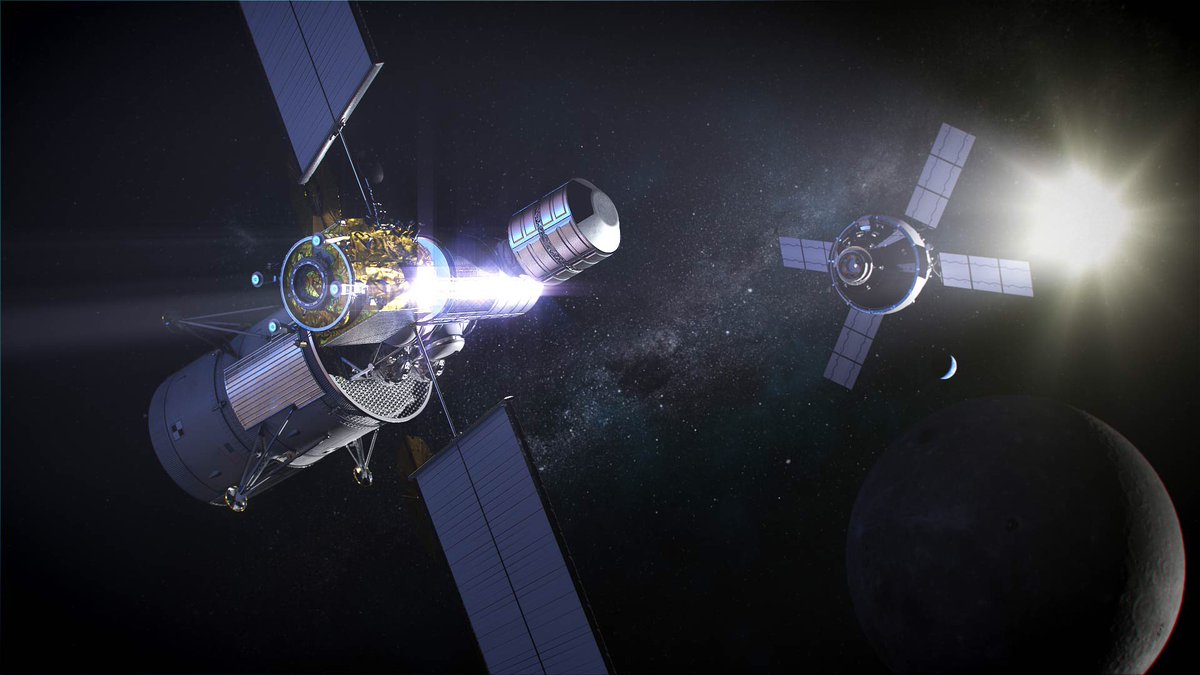
Accelerated moon program facing headwinds
The fast-track lunar landing program will cost billions of dollars more than NASA previously intended to spend over the next five years. Earlier this month, the Trump administration requested from Congress a down payment of $1.6 billion on the accelerated moon program to supplement the White House’s previous $21 billion budget request for NASA in fiscal year 2020, which begins Oct. 1.
The funding to jump-start the moon program would come from surplus Pell Grant money.
But that’s just the start. Bridenstine has said NASA will need more than $1.6 billion in additional funding per year after 2020 in order to achieve a human landing on the moon in 2024, but Trump administration officials have not set a budget for the program’s total cost.
“While I am a supporter of challenging human space exploration endeavors that can take us to the moon and eventually to Mars, based on the limited information provided to Congress it is impossible to judge the merits of the president’s budget amendment,” said Rep. Eddie Bernice Johnson, D-Texas, chair of the House Committee on Science, Space and Technology.
“We don’t know how much money will be required in total to meet the arbitrary 2024 moon landing deadline or how that money will be spent … What we do know is that the president is proposing to further cut a beneficial needs-based grants program that provides a lifeline to low-income students, namely the Pell Grants program, in order to pay for the first year of this initiative — something that I cannot support,” Johnson said in a statement.
A House spending bill released May 16 did not include the $1.6 billion supplemental budget request from the Trump administration. The additional $1.6 billion requested for NASA would pay for early work on a human-rated lunar lander, and help keep the SLS and Orion programs on track for the unpiloted Artemis 1 test flight in late 2020.
A former aerospace industry official who joined NASA in April to help develop plans for a human return to the moon by 2024 resigned from the agency this week.
Mark Sirangelo, a longtime executive at Sierra Nevada Corp., has left NASA after Congress rejected a proposal to split its human spaceflight efforts into two divisions, a “Moon to Mars Mission Directorate” and a separate unit focusing on human spaceflight operations, such as those on the International Space Station in low Earth orbit.
In a memo to NASA employees Thursday, Bridenstine wrote that Sirangelo “opted to pursue other opportunities” now that the agency is no longer pursuing the reorganization.
Maxar’s Gateway contract hailed as model for NASA-industry partnerships
As timelines have shuffled for a return of U.S. astronauts to the moon, NASA officials have maintained that the Gateway is a critical piece of a long-term exploration strategy to ensure a new series of lunar missions can be sustainable over years or decades.
Maxar beat out proposals for the Power and Propulsion Element from Boeing, Lockheed Martin, Northrop Grumman and Sierra Nevada. Company officials said Maxar will leverage its long experience in building and operating large commercial communications satellites on the PPE development.
“This program will not only achieve NASA’s goals, but will be transformational for the private sector, creating jobs and innovation along the way,” said Mike Gold, Maxar’s vice president of civil space, in a conference call with reporters Thursday.
Maxar’s SSL business unit, formerly known as Space Systems/Loral, based in Palo Alto, California, will lead development of the Gateway power and propulsion module. Maxar will partner with Blue Origin and Draper on the program.
Gold said Blue Origin will assist in human-rating and safety aspects of the PPE, while Draper will make contributions in navigation and trajectory design.
Officials have not announced a supplier for the PPE’s solar-electric propulsion system, but the spacecraft will feature large-area solar arrays that unroll like a tape measure, rather than the rigid accordion-style panels used on most satellites. Developed by Deployable Space Systems in Goleta, California, the Roll-Out Solar Array, or ROSA, technology was first demonstrated in space in 2017 in an experiment sponsored by the U.S. Air Force.
The PPE’s two solar power wings will generate at least 60 kilowatts of electricity at the beginning of the craft’s 15-year design life, more than twice the power produced by today’s most powerful commercial communications satellites, according to Al Tadros, vice president of space infrastructure and civil space.
“We build satellites that are 20 to 30 kilowatts at beginning-of-life, so handling high power is part of our core competence,” Tadros said in an interview with Spaceflight Now. “The spacecraft that we bid for the Power and Propulsion Element is a 60-kilowatt-class spacecraft, so yes, it is higher, but a lot of what we already do is applicable. So the electric propulsion technology, the power processing units, those kinds of things that we already have experience with are applicable.
“For the solar array, to get that high power, went with our ROSA product, which is a product that we’ve started to adopt for our GEO comsats,” Tadros said. “This is a higher (power) than we normally would have for a comsat, so there is some new development there, but that is fairly well understood because of our work with the supplier on the Roll-Out Solar Array.
“Other areas include the size of tanks for the xenon. There’s a large xenon load to perform electric propulsion in cis-lunar space. And then, of course, it’s going to have maneuvering capabilities to take it out to the moon and be able to support and provide the communications and power support in cis-lunar space. So a lot of things that we do, maybe on a bigger scale, but we have the right expertise and facilities to build it.”
Maxar will choose a commercial launcher for the PPE, which is expected to weigh around 11,000 pounds (5 metric tons) at liftoff. Half of that weight will be xenon propellant for the spacecraft’s ion engines, which are more efficient than conventional liquid-fueled rocket thrusters.
The company’s operations team will then fly the spacecraft for up to a year of demonstrations before NASA has the option to buy the PPE from Maxar. The $375 million firm-fixed price contract announced Thursday includes the NASA purchase option.
NASA will supply roughly $10 million to $12 million in government-furnished equipment to Maxar for the PPE, including an S-band communications system to provide a radio link with nearby vehicles around the moon, and a passive docking adapter to receive the Gateway’s future habitat, or utilization module, according to Dan Hartman, the Gateway program manager at NASA’s Johnson Space Center in Houston.
Maxar has not settled on a launcher yet for the PPE, according to Gold.
Tadros said the PPE is designed to separate from its commercial launch vehicle in Earth orbit, then use its on-board electric propulsion system to slowly raise its altitude to intercept the moon, eventually swinging into a stable halo orbit around the moon.
“It does have the capability to go into an Earth orbit, launch and separate in Earth orbit, and then transfer itself into a trans-lunar orbit and put itself into an NRHO (Near Rectilinear Halo Orbit),” Tadros said. “That’s the nominal scenario, but depending on the ultimate configuration, that Earth orbit that we separate in could be a variety of apogees and perigees. So that has not been specified or decided yet. The vehicle has a tremendous amount of capability, as any tug would, to be able to transfer from Earth orbit to lunar orbit.”
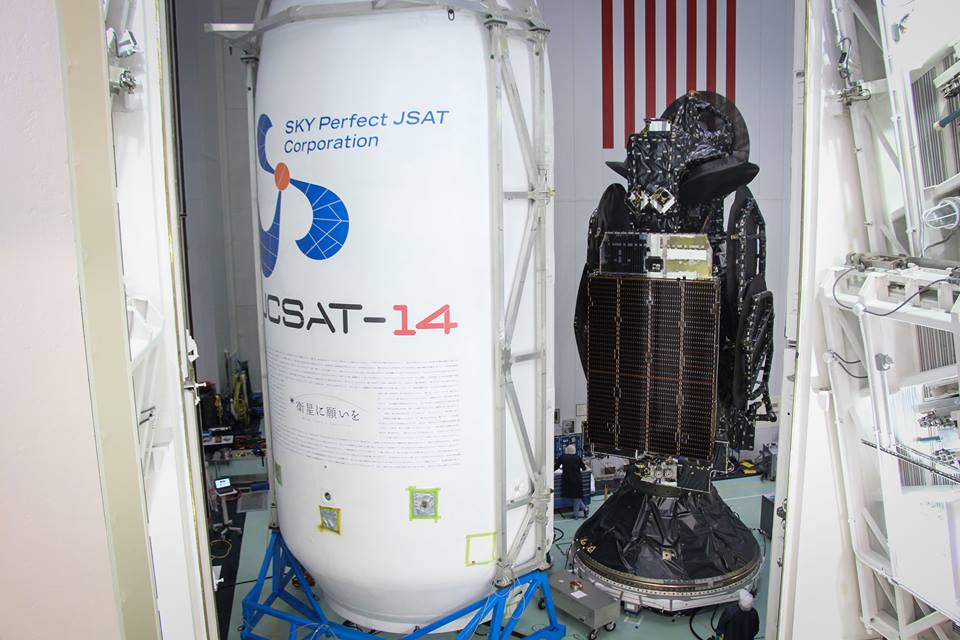
Tadros said the PPE’s ability to maneuver itself to the moon could allow Maxar to choose a lower-cost rocket, without limiting the company’s launcher options to the heaviest rockets available.
“That’s one option,” he said. “The equivalent to that is launchers that have the ability to return the first stage and provide different levels of performance — the same launch vehicle but instead of expending the first stage, it can return the first stage. Those kinds of things will all get traded and decided, but the vehicle is very capable in being able to do a combination, and that flexibility is part of the attractiveness of the PPE.”
Maxar’s specialty in the satellite business is building and operating geostationary telecom satellites, which often deploy off rockets in elliptical transfer orbits ranging between a few hundred miles in altitude up to more than 22,000 miles (nearly 36,000 kilometers) above Earth.
Tadros said the PPE could deploy from its launcher into such an orbit, called a geostationary transfer orbit, before beginning the journey toward the moon.
“But there are other considerations,” Tadros said. “For example, the Van Allen belts, the amount of time you spend in radiation, and so forth. So although mathematically you could do that, it might not be the most desirable way of launching it.”
One benefit of the PPE’s roll-out solar panels is they take up less room when stowed for launch. The spacecraft Maxar is designing is expected to fit within the volume envelope of multiple rockets.
“That is one of the design requirements, that we are compatible with a variety of launch vehicles,” Tadros said. “Their fairing sizes and such drive that requirement. We intend on the Power and Propulsion Element to be equally multi-use and multi-build, so we definitely want to make it compatible with multiple launch vehicles with ROSA and other configuration-driving items.”
Blue Origin’s possible role in Maxar’s Gateway proposal
Maxar’s partnership with Blue Origin, Jeff Bezos’s space company, in human-rating activities has raised speculation that the PPE might launch on Blue Origin’s New Glenn rocket, which is still in development for its debut launch in 2021.
The New Glenn will be a heavy-lift rocket with a recoverable and reusable first stage. Blue Origin is also working on a privately-funded lunar lander called the Blue Moon, which could deliver experiments, cargo and astronaut crews to the moon’s surface.
A selection statement outlining NASA’s rationale for picking Maxar for the PPE contract was released Friday, revealing new details about the company’s proposal.
Maxar’s proposal to NASA included an unnamed co-manifested lunar lander, which would ride into space on the same launch vehicle as the Gateway power module. While the NASA selection statement does not identify Maxar’s preferred rocket for the PPE, the agency’s source selection official, Michele Gates, nicked Maxar’s proposal with a “weakness for utilization of a currently unproven heavy-lift launch vehicle that adds uncertainty and risk to the launch vehicle ground processing and launch operations.”
“While I note that this issue does increase the risk of SSL’s ability to successfully demonstrate its capability, I also acknowledge SSL’s mitigation plan to maintain compatibility of its developed capability across multiple launch vehicle options while monitoring the launch vehicle development process,” Gates wrote in the NASA selection statement.
Two rockets in the New Glenn’s class are currently flying: SpaceX’s Falcon Heavy and United Launch Alliance’s Delta 4-Heavy. ULA’s new Vulcan Centaur rocket will offer similar performance on a high-energy launch as the Delta 4-Heavy and the New Glenn, and somewhat more than the Falcon Heavy, assuming SpaceX sets aside a fuel reserve to recover the Falcon Heavy’s boosters.
According to the NASA selection statement, Maxar’s PPE proposal was the least expensive of the five bids the agency received from industry.
Maxar is designing the PPE to be refueled with xenon in space, enabling repeated maneuvers to different stations around the moon.
The “delivery-in-orbit” nature of Maxar’s PPE contract is common in the commercial satellite industry, but it’s new to NASA.
“We are procuring it (the PPE) in a way that we haven’t done before,” Bridenstine said. “We will have an option to take possession of it after it’s on orbit. In other words, we’re buying it commercially. They’re building it, and then if it all tests well, then we acquire it as a country. This is a different way of procuring it, and it is a big change, and we need to get used to this kind of change as an agency, and we are. We’re making these changes quickly.”
NASA intends to procure the Gateway’s next section, the pressurized element, in a similar fashion later this year. The human-rated lunar lander will also be developed commercially.
“I think you can say that the business practice for PPE has already been a success, just given that NASA went through the process and awarded a contract as quickly as it did,” Gold said. “The technology can be challenging, but the procurement process can be of equal if not greater importance sometimes — in developing and actually deploying hardware — than the engineering.
“I believe that this was the most commercial program that NASA has run that doesn’t have the word commercial in it,” Gold said, a reference to NASA’s commercial cargo and commercial crew programs that fostered new privately-developed spacecraft to service the International Space Station. “And I think it is representative of the future for the agency and the procurement process, and I think this has already been successful in moving quickly and getting a high-quality and affordable and reliable product.”
Email the author.
Follow Stephen Clark on Twitter: @StephenClark1.


